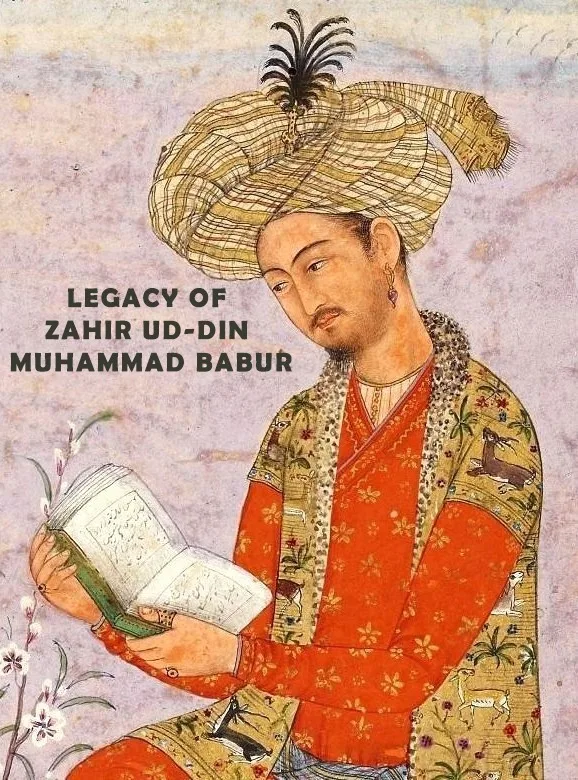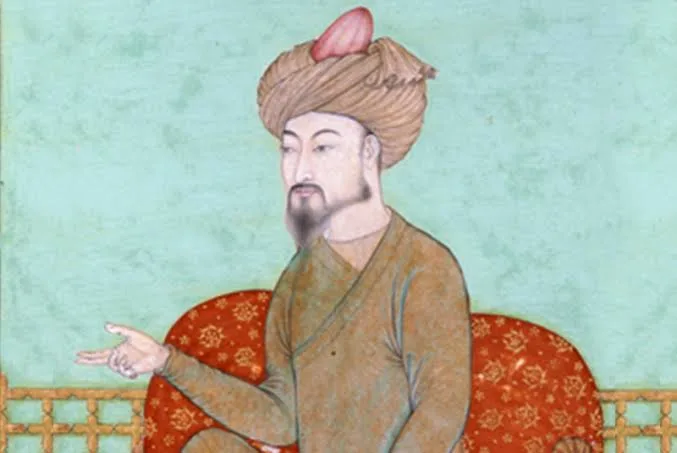The Mughal Dynasty, distinguished by its unprecedented opulence, art, and architectural achievements, has left an indelible mark on the cultural and historical landscape of the Indian subcontinent. This monumental legacy traces its origins to a figure of unparalleled valor and foresight, Zahir-ud-din Muhammad Babur. Babur’s contributions to the establishment and consolidation of the Mughal Empire extend far beyond the realms of military conquests, embodying a nuanced blend of resilience, strategic brilliance, and visionary political leadership. His endeavors set in motion the dynamics of an empire that would dominate the Indian subcontinent for centuries, fostering an era of cultural renaissance and architectural grandeur that continues to captivate the imagination of the world.
Introduction
Babur was born into the renowned Timurid dynasty in 1483, in what is now known as Uzbekistan. He was a descendant of two of history’s most powerful conquerors: Timur on his father’s side and Genghis Khan on his mother’s. This renowned pedigree not only gave him a claim to enormous lands, but it also drove his ravenous desire to build his own empire. Despite several losses in Central Asia, Babur’s ambitions finally led him to India, enticed by its richness and a fractured political landscape that provided sufficient prospects for conquest (Richards, 1993). Babur’s first expedition into India resulted in the pivotal Battle of Panipat in 1526, when he defeated the Sultan of Delhi, Ibrahim Lodi. This battle was not only a military triumph, but also a strategic coup that paved the way for Mughal rule in India. Babur’s military tactics, particularly his pioneering employment of field artillery and cavalry, set new standards for Indian combat. His successes at Panipat, followed by those at Khanwa and Ghagra, not only established his military might, but also solidified his dominance over Northern India (Dale, 2004).
Babur’s Governance
Babur’s governance strategy was distinguished by his attempts to combine India’s different regions into a centralized framework while honoring local customs and traditions. This inclusive method not only ensured his people’ devotion, but also permitted the seamless integration of Persian culture with the indigenous Indian mentality. The end result was a complex cultural fusion that came to define the Mughal period (Eraly, 2007). Babur’s political acumen was obvious in his understanding of the complexity of Indian culture, which was characterized by a diverse range of languages, faiths, and customs. His government attempted to reconcile these gaps with measures that encouraged tolerance and diversity.
One of Babur’s most important governance achievements was the construction of a dual system of administration that balanced central power with local autonomy. At the center of this system was the Mansabdari system, which, although not completely established during Babur’s reign, set the groundwork for what would become a pillar of Mughal administration. This system classified all imperial officials and military commanders according to their rank (mansab), which defined their salary and the size of their contingent. This system enabled a consistent type of administration while still accommodating the empire’s members’ various military and bureaucratic traditions.
Babur’s economic ideas were similarly forward-thinking. Recognizing the need of a stable and thriving economy for the survival of his kingdom, Babur enacted policies to promote commerce and agriculture. He concentrated on infrastructure development, such as road and irrigation projects, which improved commerce and agricultural output. These actions not only helped the empire’s economic situation, but also established the framework for the blossoming of trade and commerce that would define the Mughal period.

Perhaps one of Babur’s most lasting legacies is the cultural fusion that evolved during his reign. Babur promoted Persian art, literature, and architecture while also embracing the rich traditions of the Indian subcontinent, creating a cultural interchange atmosphere that enhanced Mughal culture. This fusion of Persian and Indian components was evident in a variety of areas, including language, as Persian became the language of government and high culture, coexisting alongside local languages and dialects.
Babur’s reign also included judicial and social changes. He worked to achieve justice and equality by constructing a judicial system based on Islamic law while also appeasing his Hindu people’ customary rules. This inclusion and impartiality in the legal sphere strengthened Babur’s image as a king who cherished the welfare and rights of all his people, regardless of their religion or ethnic origin.
Cultural and Architectural Contributions
Under Babur’s leadership, the Mughal Dynasty produced unforgettable contributions to art and architecture, establishing a foundation for the wealth and grandeur that would characterize the age. Although Babur’s successors were mostly responsible for the architectural wonders that are synonymous with the Mughal Dynasty, Babur himself lay the groundwork for this legacy. His deep enthusiasm for nature and architecture manifested itself in the creation of precisely constructed gardens, such as Agra’s Ram Bagh. These gardens, with their detailed architecture and meticulous use of water features, reflected Persian influences and represented Babur’s attempt to combine parts of his Central Asian ancestry with the Indian terrain, resulting in a distinct cultural synthesis (Koch, 1997).
Babur’s sponsorship went beyond construction to the arts, ushering in a time of thriving cultural activity. His literary works, particularly the Baburnama, provide insight into the cultural and social dynamics of the period. The Baburnama, written in Chagatai Turkic, is more than just an autobiographical chronicle of his conquests; it also serves as a literary canvas for his views, natural observations, and insights into the civilization he found. This significant book exemplifies the combination of literary talent and historical study that would come to define the intellectual pursuits promoted inside the Mughal court (Thackston, 1996).
Babur’s accomplishments went well beyond the battlefield, creating a rich tapestry of cultural and architectural developments that not only adorned but also shaped the Indian subcontinent’s cultural destiny. His garden design endeavors offered a new style to the Indian architectural environment, combining usefulness and aesthetic appeal to create settings that were both meditative and in harmony with nature. These gardens were symbolic of the Mughals’ love of nature and played an important role in the development of the Mughal garden culture, which would peak in the following centuries.
Babur’s literary legacy, as shown by the Baburnama, emphasizes the value of intellectual and cultural activities inside the Mughal Empire. It laid the groundwork for the growth of the arts and literature, creating an atmosphere conducive to academic and artistic expression. The Baburnama, in particular, is essential not only for its historical content, but also for its contributions to the evolution of Persian literature and effect on Mughal court literary culture.
Babur’s cultural and architectural accomplishments established the framework for the Mughal Dynasty’s legacy, which influenced the creative and architectural environment of the Indian subcontinent for centuries. Babur’s sponsorship of the arts, together with his architectural achievements, ushered in a time of cultural synthesis and creative blossoming that honored the convergence of many traditions and viewpoints. His legacy, therefore, is one of cultural enrichment and architectural innovation, which set the scene for the luxury and grandeur that the Mughal Dynasty would be known for.
The Legacy of Tolerance and Administration
Babur’s legacy is notable for the spirit of religious tolerance and administrative efficiency that he instilled in his empire’s governing institutions. Babur, a pious Muslim, handled his realm’s religious diversity via a policy of tolerance and acceptance. This attitude was more than just a philosophical position; it was a practical tactic that was critical in preserving social peace and winning the loyalty of his domain’s Hindu population. Babur maintained a coherent and united government, which aided in the establishment of his embryonic kingdom, by cultivating an atmosphere of religious tolerance.
Babur’s administrative skills were also seen in his focus on fairness and meritocracy. He grasped early on that his empire’s survival and prosperity depended not just on military force, but also on the efficiency and fairness of its administration. To that purpose, Babur implemented rules that stressed merit and ability above lineage and favor, creating the basis for an efficient and egalitarian administrative apparatus. These measures aided in the development of a governance model defined by responsiveness and flexibility, characteristics that would come to define the Mughal administration in subsequent centuries (Metcalf & Metcalf, 2006).
Under Babur’s rule, the merging of religious tolerance with administrative efficiency constituted a substantial break from the region’s previous government paradigms. This dual strategy not only legitimized Babur’s reign, but also created the groundwork for the Mughal Empire’s pluralist society. By emphasizing justice and meritocracy, Babur established a government system that rewarded and encouraged talent regardless of religion or socioeconomic background. This not only maximized the potential of his subjects, but also instilled loyalty and faith in the government.
Babur’s policies of religious tolerance and administrative meritocracy reshaped the empire’s social and political fabric. They contributed to the reduction of religious tensions and the development of a mutual respect culture among the empire’s varied population. This culture of tolerance and inclusion, along with a merit-based administration structure, greatly contributed to the Mughal Empire’s stability and success, distinguishing it from its contemporaries.
Babur’s legacy of tolerance and efficient administration reflected his visionary leadership and deep awareness of the problems of ruling a varied and huge kingdom. His initiatives not only aided the easy integration of many religious and ethnic groups, but they also produced a government model that was praised for its justice and efficiency. Babur supported the concepts of religious tolerance and administrative meritocracy, which contributed to the Mughal Empire’s endurance and prosperity.

Mr. Khalid Taimur Akram is an Executive Director, Pakistan Research Center for a Community with Shared Future (PRCCSF).


